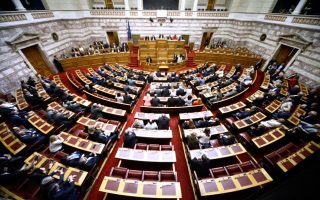Alexis Tsipras: Coming full circle in seven years

“I can’t believe we came in second,” Alexis Tsipras told an associate on May 6, 2012, as he walked into SYRIZA’s headquarters at Koumoundourou Square in downtown Athens. Seven years and 20 days later, on May 26, 2019, the party came full circle. Again, he couldn’t believe they came second.
Those two electoral milestones mark “the seven Tsipras years,” a period during which his political career was marked by a string of contradictions – deeply divisive rhetoric coming from a smiling face; social sensitivity blunted by Soviet-style callousness, most evident in the reaction to last summer’s devastating fires; quixotic aggression against “Madame Merkel” in 2015; and bare realpolitik under German Chancellor Angela Merkel’s aegis over the Prespes name deal in 2018.
This bizarre seven-year period stems from a political career that took 25 years to develop, starting in 1988 when Tsipras joined the Communist Youth of Greece (KNE). “Some guys from KNE had come to my high school to enlighten us on the 1988 sit-ins and lured me in,” he told the student magazine Schooligans in an interview a decade ago.
But the KNE “talent scouts” were soon disappointed in their new recruit’s lack of zeal for communism. He didn’t take well to persistent guidance, but was enchanted by the fundamental principle of Marxism, that socialism will “inevitably” come after capitalism. “It was a delusion I needed at the time,” he later confessed. His adolescent tendency toward self-delusion was something that grew into a deeper and more permanent compulsion.
He dropped out of KNE in 1991, at the time of the breakup of the Synaspismos leftist coalition (originally an alliance of the Greek Communist Party [KKE], the Greek Left [EAR] and other center-left groupings). At around the same time, when he was still in the second year of high school, he was elected president of the 15-member student council at his school in the neighborhood of Ambelokipi. He came first in the student vote but also needed the support of the sitting members of the council, all of whom were seniors. According to one version of events, he got their support by letting them take the credit for organizing the spring break holiday. The undocumented understanding was that the only way he would allow them to carry on unopposed with plans for the 1992 spring break holiday to Rhodes was to elect him president. He was just 17 years old, but he already understood the notion of quid pro quo. His popularity among the student body was also due to the fact that he had distinguished himself in the 1990 sit-in protests against educational reforms introduced by the government at the time.
The techniques and attitude he had adopted during the protests followed him throughout his career. A combination of courage and self-delusion with audacity and cynicism allowed him to make incredible leaps, sometimes into the future, but also into the void.
He was admitted to the Civil Engineering Department of the National Technical University of Athens in 1992 but has admitted to stepping into the lecture theater mainly for student meetings. He founded the student organization Enceladus, getting 20 percent of the vote in student elections and coming second after KNE’s Panspoudastiki. The Synaspismos (SYN) talent scouts were quick to recruit him. The party’s president at the time, Nikos Constantopoulos, immediately spotted his potential. Tsipras was elected president of SYN’s youth wing in 1999 but refused to become a paid party official. He insisted on maintaining a certain level of independence wherever he was involved. He drove a motorcycle for years, played five-a-side soccer, liked attending Panathinaikos matches, lived in Exarchia and listened to Manos Hadjidakis, Cesaria Evora and Thanasis Papaconstantinou.
He did not take sides in the battle for Constantopoulos’ successor in 2004, but when Alekos Alavanos won, the new party president reached out to the 30-year-old in the hopes of sapping the influence of the old guard and further entrenching his position. Two years later, he nominated Tsipras for Athens mayor, sidelining veteran Michalis Papayiannakis, in the election against New Democracy’s Nikitas Kaklamanis and PASOK’s Costas Skandalidis in October 2006. Campaigning under the slogan “We’re getting in the game,” he came third with 10.5 percent of the vote. Kaklamanis was the first conservative politician to discern Tsipras’ potential, but also his rather flexible relationship with the truth. “You’re a liar through and through,” the older politician told Tsipras during a meeting of the municipal council in 2008. A couple of hours later, Kaklamanis invited Tsipras to his office and gave him a gift for his nameday.
Becoming leader
Alavanos’ gift to Tsipras was the leadership of Synaspismos. The veteran politician moved to the presidency of a new party he had created, an umbrella movement called Coalition of the Radical Left (SYRIZA). He had failed to properly appreciate the implications of the fact that Synaspismos was the only member of SYRIZA that enjoyed state funding and parliamentary privileges – and that these all came to Tsipras. The party’s new president soon put these perks to good use, attracting more parties and slowly pushing Alavanos into the cold. When the older politician tried to hold him to account, Tsipras showed him the door. As simple as that.
Tsipras has a reputation for inspiring a sense of patronage, especially among men over the age of 60 who view him a bit like a son, something that was apparent with Alavanos, but also with former foreign minister Nikos Kotzias, not to mention the founders of the recently set up Gefyra (Bridge) movement, which is seeking some form of alliance with the center-left Movement for Change (KINAL). Captivated by his polite manner, they seem to believe they can influence him. However, many soon discover that behind the image of affability lies a razor-sharp, calculating instinct.
In the general election of October 2009, SYRIZA squeezed into Parliament with 4.6 percent of the vote, but the credit crisis had already started, presenting myriad opportunities for the party to increase its appeal. Tsipras took advantage of these and SYRIZA shot to 26.9 percent in the June 2012 runoff, losing to New Democracy by just 2.8 percent. He was now leader of the main opposition party, which went on to win the European elections in 2014, as well as two general elections and a referendum in 2015. The left had arrived and Tsipras was sworn in as prime minister on January 26, 2015. His first stop was the World War II executions memorial in the suburb of Kaisariani – a symbol of the new “resistance against the Germans.”
Great contradictions
Critics accuse Tsipras of exploiting the divisions of the 1940s by building his anti-memorandum rhetoric on the basis of the verbal style of the EAM resistance against the Nazi occupation, thus compelling the Greek public to view the debt crisis through the divisive lens of the civil war. For others, the rift of the 40s defined the founding myths of the post-dictatorship democracy. When even the right adopted leftist rhetoric, only a politician with convincing leftist credentials could assuage public opposition to the demands of participation in the European Union.
Some believe that Tsipras is a danger even to democracy itself. The ease with which he butted heads with Greece’s creditors and then adapted to their harshest demands suggests that perhaps he would be willing to work with whoever offered him support. Others see him a force that has given democracy a fresh boost because he had the tenacity to challenge the conservative European mentality and the Greek establishment. Yet even his most fervent supporters admit he is a man of intense contradictions.
This master of populism has often disregarded the political cost of certain decisions (the third memorandum and the Prespes name deal most notably), while his obsession with the idea that the justice system and the media are being manipulated by the establishment’s hard core resulted in his government doing just that with his tacit approval (the TV license tender, the Novartis affair). The politician who sometimes tears up when speaking in private about incidents of social injustice is the same man who can appear devoid of any emotion when he feels threatened, as he did in the wake of the east Attica fires last summer.
Shortly before his 45th birthday, Tsipras had his first taste of defeat. Almost everyone is certain that next month, four years after the referendum, he will be saying goodbye to an Alexandria he is losing, but few believe that he will bow out of politics as all of his predecessors in the post-junta era – with the exception of Andreas Papandreou – have after suffering a defeat. In either case, a seven-year cycle of division appears to be coming to a close, heralding a new one for Greece, and possibly for Alexis Tsipras as well.
From rebellious teen to premier
1990: Aged 16, Alexis Tsipras is one of the leading figures in the sit-in protests at his school in the central Athens district of Ambelokipi, a part of action by students across the country objecting to educational reforms introduced by the New Democracy government at the time.
2006: Running on the Synaspismos ticket, Tsipras gets 10.5 percent of the vote for Athens mayor and a seat on the municipal council. The young motorcycle-riding, Exarchia-based politician played up his “cool” image in a bid to introduce a more “modern” note to Greece’s left wing.
2008: Alekos Alavanos takes on the presidency of Coalition of the Radical Left (SYRIZA), giving the leadership of Synaspismos to Tsipras. It was decision he would come to regret as his young protege managed to dethrone him within the space of a year.
2012: SYRIZA comes in second place in the national election and Tsipras is sworn in as the chief of the main opposition, which sets its sights on the seat of power.
January 25, 2015: SYRIZA wins the election with 36.3 percent of the vote. Tsipras partners with Panos Kammenos and his small far-right, nationalist, anti-austerity Independent Greeks party and is sworn in as prime minister. The government embarks on a collision course with Greece’s European lenders that lasts six months and is estimated to have cost the country in the neighborhood of 100 billion euros.
July 5, 2015: Tsipras puts the European Union’s proposal for a fresh program to a referendum. “No” wins with 61.3 percent as Greeks reject the terms of the deal. The prime minister executes his most notorious volte-face, with the Greek word for somersault, “kolotoumba,” becoming an international catchphrase for the way he turned the “No” into a “Yes.”
June 12, 2018: Tsipras and Prime Minister of the Former Yugoslav Republic of Macedonia Zoran Zaev sign the Prespes agreement, along with their respective foreign ministers, Nikos Kotzias and Nikola Dimitrov. The deal renaming the country North Macedonia cost SYRIZA serious popularity points among the electorate and drove a wedge into the coalition with Independent Greeks.





